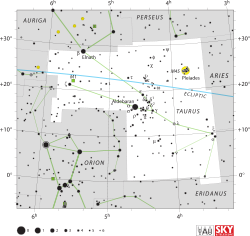Delta1 Tauri
| Observation data ICRS )
| ||
|---|---|---|
| Constellation | Taurus | |
| Right ascension | 04h 22m 56.09253s[1] | |
| Declination | +17° 32′ 33.0487″[1] | |
| Apparent magnitude (V) | +3.772[2] (3.90 + 9.50)[3] | |
| Characteristics | ||
| Spectral type | G9.5 III CN0.5[4] | |
| U−B color index | +0.801[2] | |
| B−V color index | +0.919[2] | |
| Absolute magnitude (MV) | +0.41[5] | |
Semi-amplitude (K1)(primary) | 3.0 km/s | |
| Details Myr | ||
| δ¹ Tau Ab | ||
| Mass | 1.28±0.1 M☉ | |
| Database references | ||
| SIMBAD | data | |
Delta¹ Tauri (δ¹ Tauri, abbreviated Delta¹ Tau, δ¹ Tau) is a double star in the zodiac constellation of Taurus. Based upon an annual parallax shift of 20.96 mas as seen from Earth,[1] it is located roughly 156 light-years distant from the Sun. The system is faintly visible to the naked eye with a combined apparent visual magnitude of +3.772.[2] It is considered a member of the Hyades cluster.[7]
The two constituents are designated δ¹ Tauri A and B. A is itself a binary star with components designated δ¹ Tauri Aa (officially named Secunda Hyadum /sɪˈkʌndə ˈhaɪədəm/, the traditional name for the entire system)[10] and Ab.
Nomenclature
δ¹ Tauri (Latinised to Delta¹ Tauri) is the system's Bayer designation. The designations of the two constituents as Delta¹ Tauri A and B, and those of A's components - Delta¹ Tauri Aa and Ab - derive from the convention used by the Washington Multiplicity Catalog (WMC) for multiple star systems, and adopted by the International Astronomical Union (IAU).[11]
The system bore the traditional name Hyadum II, which is
In
Properties
Delta¹ Tauri A is a single-lined spectroscopic binary with an orbital period of 529.8 days and an eccentricity of 0.42.[6] The visible member, component Aa, is an evolved G- or K-type giant star with a stellar classification of G9.5 III CN0.5.[4] The 'CN0.5' suffix indicates a mild overabundance of cyanogen in the outer atmosphere. It is chromospherically active and shows a radial velocity variation of 9.3±0.2 m/s with a period of 165±3 d.[7] The primary, component Aa, has 2.8 times the mass of the Sun, while the secondary, component Ab, has 1.3 times the Sun's mass.[7]
Delta¹ Tauri B is a magnitude 13.21 visual companion separated by 111.8 arcseconds from A.[3] It is most likely not physically related to the main star.[17]
References
- ^ S2CID 18759600.
- ^ .
- ^ doi:10.1086/323920.
- ^ doi:10.1086/191373.
- S2CID 12136256.
- ^ S2CID 119387088.
- ^ S2CID 33898282, A138.
- S2CID 53666931.
- ^ "del01 Tau". SIMBAD. Centre de données astronomiques de Strasbourg. Retrieved 2017-08-08.
{{cite web}}: CS1 maint: postscript (link) - ^ a b "Naming Stars". IAU.org. Retrieved 16 December 2017.
- arXiv:1012.0707 [astro-ph.SR].
- University of Illinois, retrieved 2017-08-09.
- ^ "IAU Working Group on Star Names (WGSN)". Retrieved 22 May 2016.
- ^ "WG Triennial Report (2015-2018) - Star Names" (PDF). p. 5. Retrieved 2018-07-14.
- ISBN 978-986-7332-25-7.
- ^ (in Chinese) 香港太空館 - 研究資源 - 亮星中英對照表 Archived 2008-10-25 at the Wayback Machine, Hong Kong Space Museum. Accessed on line November 23, 2010.
- S2CID 14878976.

